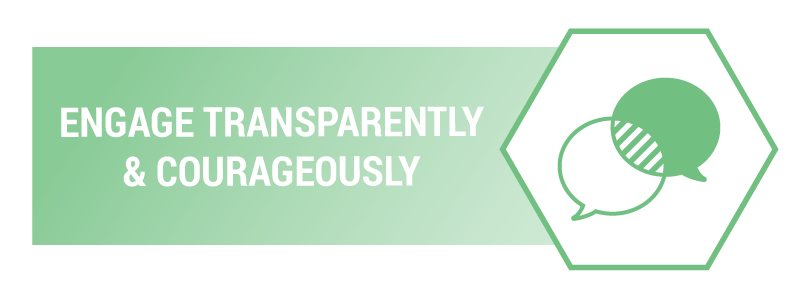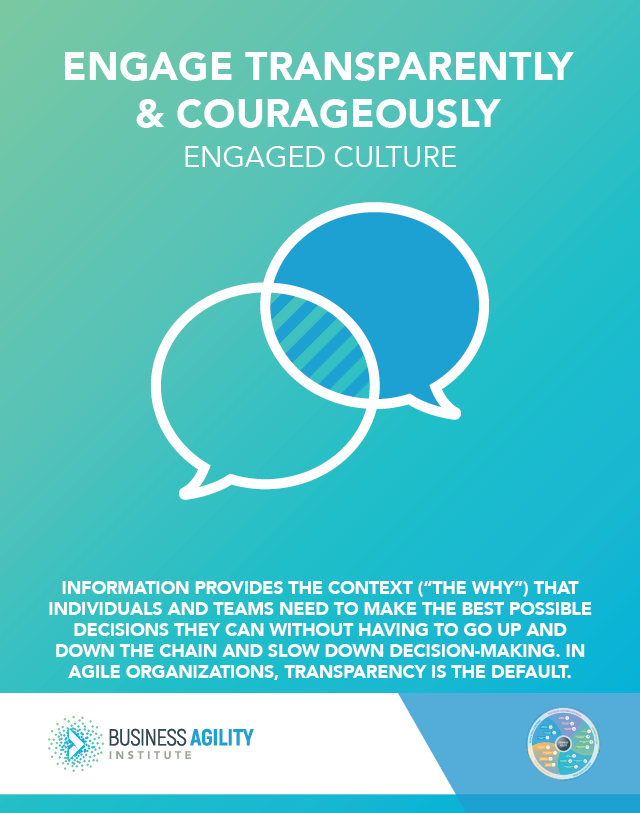Domains of Business Agility
- Responsive Customer-Centricity
- / Fiercely Champion The Customer
- / Sense & Respond Proactively
- / Integrate Diverse Ideas
- Engaged Culture
- / Cultivate A “Learning Organization”
- / Engage Transparently & Courageously
- / Embed Psychological Safety
- / Act As One
- Value-Based Delivery
- / Unleash Workflow Creatively
- / Prioritize. Prioritize. Prioritize.
- / Deliver Value Sooner
- / Seize Emergent Opportunities
- Flexible Operations
- / Adapt Strategies Seamlessly
- / Fund Work Dynamically
- / (Re)Organize Structures Fluidly
- / Balance Governance And Risk
- People-First Leadership
- / Foster Authentic Relationships
- / Empower With Accountability
- / Realize People’s Potential
In an empowered organization, transparency is a necessity, not a “nice to have.” Information provides the context (“the why”) that individuals and teams need to make the best possible decisions they can without having to go up and down the chain and slow down decision-making. In agile organizations, transparency is the default when it comes to information. Good and bad news should both be shared transparently and courageously. While there will always be some things that shouldn’t be shared for legal or strategic reasons, organizations should insist on keeping restricted information to a minimum.
Because the move toward transparency is a bold one, leaders need to model courage to make it happen. Leaders must not only engage transparently and courageously, they must facilitate the flow of information in all directions: up, down, and — most importantly — across your organization.
Primary Behaviors
The following 7 behaviors strongly contribute to the ability to engage transparently & courageously.
B20: Everyone challenges the status quo and is open to being challenged: “We’ve always done it this way” is not seen as a valid reason for continuing to “do it that way.” Everyone feels safe to question how things are done, and in return is open to having their assumptions, biases, and mental models questioned in a respectful way. This openness is true for all levels of experience and position.
B21: Everyone defaults to the open sharing of information: Information, policies, data, plans, and outcomes are openly shared at all levels of the organization, across the organization. Rather than share on a “need to know” basis - as much information as possible is available to anyone.
B22: Leaders model desired behavioral changes before asking others to do it: Leaders don’t just talk about the needed behavioral changes in the organization. They are among the first to personally adopt the new behaviors as habits.
B23: Leaders communicate and discuss the why, what, and impact of change early and often: Leaders take an active role in leading change by communicating as early as possible about impending changes – enabling the organization to understand the impact, rather than second-guessing it. Leaders create opportunities for two-way dialogue about significant changes and share the background and drivers for the change. Leaders are involved throughout the change process, not just at the beginning, to reinforce, align, and amplify key change points.
B24: Everyone makes work visible: The organization consistently uses shared systems and processes to organize and prioritize all of the work of the organization. Everyone uses these systems and processes so that the “cost” of current work and the capacity for future work is understood. These systems may be informal (not necessarily a complex tool) and are used to promote two-way conversations and decision-making about work capacity.
B25: Leaders ensure that governance controls and approval processes (and any changes to them) are clearly articulated and communicated: Leaders ensure that governance is documented and accessible to everyone who is affected by the policies and procedures. No one needs to rely on verbal mythology of “how things are done around here.” Onboarding for new employees includes education on governance, and changes are widely communicated to everyone who might be affected by a change.
B26: Leaders share the rules behind salary and compensation with everyone: The logic and rules for compensation are consistent and accessible to everyone in the organization.


